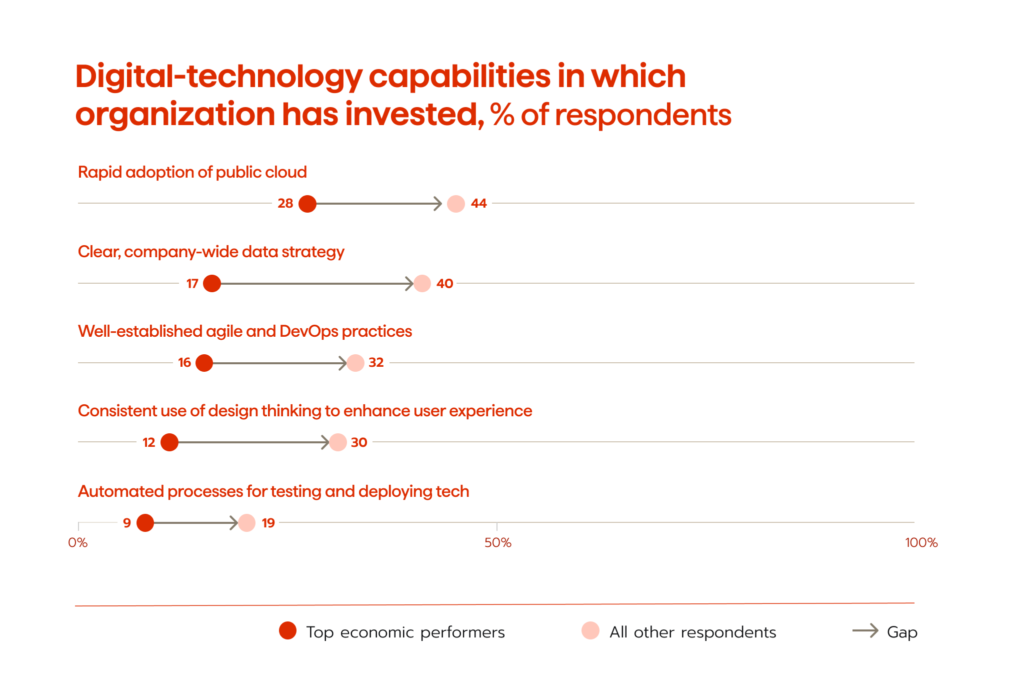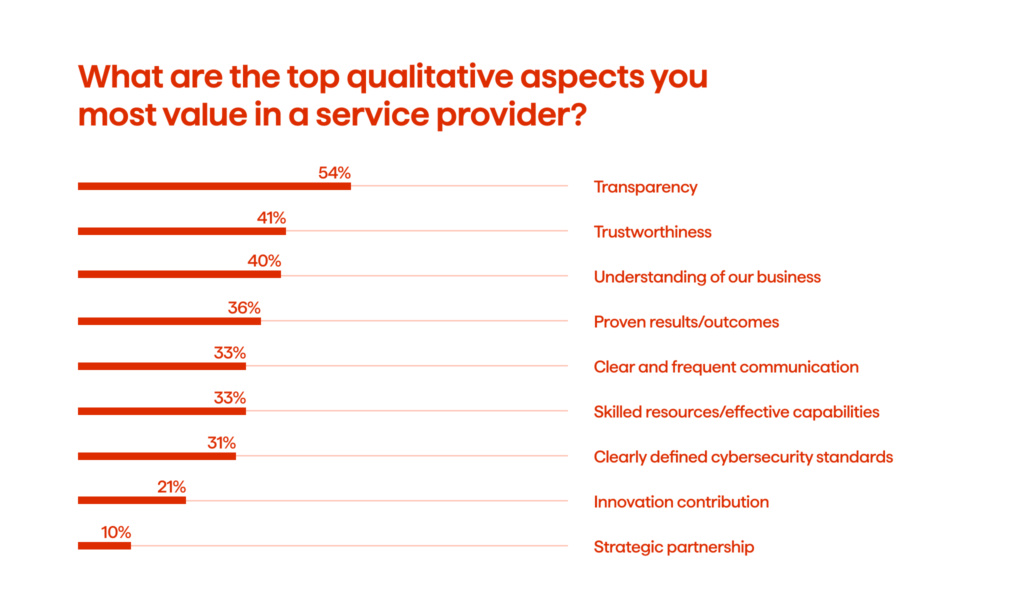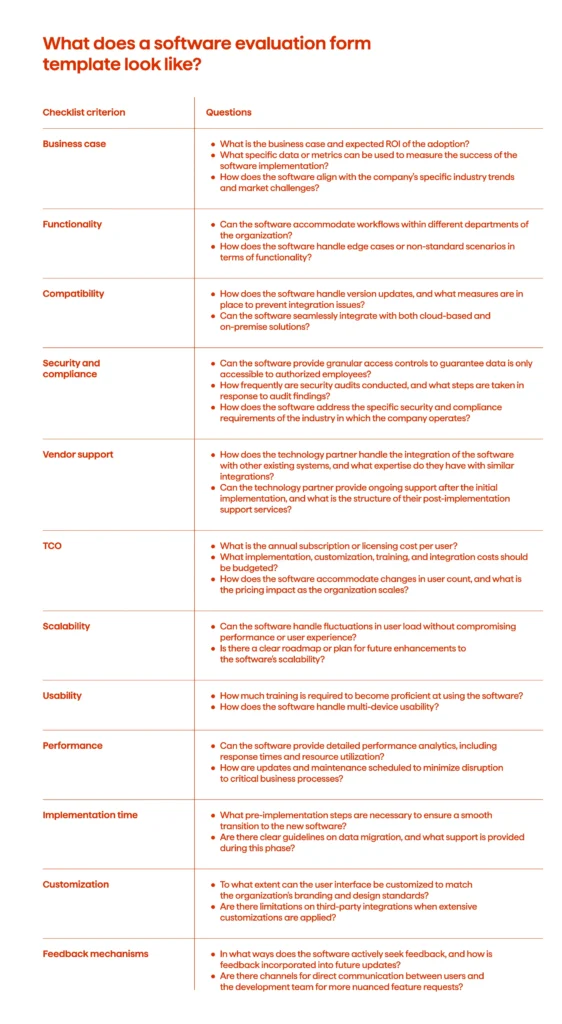Ensuring Excellence: A Comprehensive Software Evaluation Checklist

May 6, 2025 13 min read
Amidst the flood of options, selecting the right software is no minor task.
Choosing impactful software is part art and part science. The art lies in having the vision to look beyond the surface and finding a solution that aligns with your strategic business trajectory. The science lies in rigorous analysis of every capability, cost, and compromise. Blend these skill sets, and the payoff is substantial. A McKinsey report states that 51% of the top economic performers lean their competitive advantage on digital technology which gains them tangible financial results. With the right evaluative eye, any organization can choose solutions that secure the most elusive of outcomes: improved productivity without disrupted operations. In this article, we’ll examine the essentials that enable these benefits.
What Is Software Evaluation?
Software evaluation refers to the upfront strategic analysis of whether to implement new software or not. It is a process where experts thoroughly examine the business rationale, requirements, risks, alternatives, and resource needs before the final adoption decision. The goal of the software evaluation is to take a full strategic view before committing resources. This prevents organizations from prematurely going down the software procurement path before determining if a new software is the optimal solution.
The whole mechanism usually requires companies to comprehensively gather requirements across business units on workflows, features, data, security needs, and other capabilities the new system must fulfill to deliver value. The analysis examines if business objectives can be met through improvements in the existing systems versus investments in new products. Interestingly enough, there is a strong correlation between digital adoption and business success. For instance, top economic performers have been steadily investing in digital technology and tech assets (see Fig. 1), according to a 2023 McKinsey study.

In addition, the evaluation maps out in-house development, customization, and software partnership alternatives to assess if purchasing the off-the-shelf software is the right approach. It also considers the Total Cost of Ownership (TCO), risks, and any technology constraints to scrutinize organizational readiness for a new software project. The output is a business plan with cost-benefit analysis, ROI projections, and recommendations on whether to proceed with the new software or not. Essentially, it lays the analytical groundwork for conducting an excellent software adoption that provides maximum business value.
Learn how Avenga created a fine-tuned automated budget-forming system for a leading biopharma enterprise. Success story
Who Should Participate in the Software Evaluation Process?
Software evaluation and selection processes are most effective when they include input from a diverse and cross-functional group of organizational stakeholders. Participation should span both high-level strategic perspectives and on-the-ground implementation realities. Creating a pool of stakeholders implies a grasp of varied requirements. Markedly, when key user groups feel represented, there is increased adoption and utilization of the selected software. Here are some key details on who can and should participate in the software evaluation process:
- Business executives provide strategic direction on business goals, budgets, and timelines. They approve the final software selection.
- IT leadership offers technical perspectives on infrastructure, security, integrations, and the customizations needed and can spearhead software implementation.
- Key end-users test software usability and share user experience feedback.
- Outside technological partners share independent unbiased insights as subject matter experts and provide additional assistance with implementation.
- Department heads represent their functional needs and workflows and consider the software’s fit.
- Finance and procurement recommend budget availability, licensing models, and software provider negotiation strategies.
- Operations managers evaluate the software’s impact on day-to-day processes and training needs.
- Project managers facilitate the software selection process and coordinate cross-functional collaboration.
In order to facilitate constructive cross-functional discussions, it is a viable option to establish transparent governance for the evaluation process upfront. A core project team or steering committee with representatives from each area can coordinate activities and align perspectives. This group can identify shared requirements, gather feedback, manage demos, and discuss evaluation criteria. With proactive communication planning, the evaluation process can synthesize diverse vantage points into an integrated view of the suitable software for the organization.
What Are the Key Criteria in the Software Evaluation Checklist?
Companies work with several integral criteria that comprise the body of a software evaluation template. A thorough examination of these things from the standpoint of various stakeholders, from executives to end users, paves the road for informed decision-making. Additionally, being more than a one-size-fits-all formula, the software evaluation framework doesn’t just assess all the factors but focuses on those most critical to the organization. Here is a comprehensive list of things that are essential in this quest:
1. Business Case
The business case for new software adoption plays a crucial role in the checklist, as all evaluation criteria should ultimately connect back to measurable business impacts that justify the investment. The software that best demonstrates the potential to achieve the target outcomes, deliver ROI, and align to strategic objectives should rank higher. What’s important is to have stakeholders agree on the expected benefits before the evaluation, because this enables companies to stay focused on their core vision. In this way, the business case factors in all resource requirements, staff capabilities, and change management needs, and helps determine if the software investment is financially viable and aligned with strategic business goals.
2. Functionality
As a baseline of evaluation, functionality outlines must-have technical capabilities. When assessing functionality, organizations outline the necessary features based on their integral workflows and processes. They meticulously determine whether the software provides complete coverage or only partial functionality and then look for gaps where there is a need for workarounds or custom solutions. This part of the process requires specialists to outline key tasks and processes that the software must reliably perform to deliver value and confirm that the software can execute high priority use cases out of the box. A rigorous assessment of functional alignment makes sure that the solution caters to the objectives before major commitment from the company’s side.
3. Compatibility
The software needs to integrate seamlessly with an organization’s existing infrastructure to avoid costly upgrades, complex customization, or the purchase of additional solutions to fill gaps. A compatibility evaluation is integral to verifying whether the new software will integrate into the existing technology environment. Like pieces of a puzzle, the software must fit with the overall IT infrastructure. Consideration of compatibility factors helps avoid situations where the software may technically meet requirements but has a mismatch with hardware, operating systems, networks, databases, or other integral technologies in the ecosystem. In this way, compatibility assessments lessen friction and rework down the road.
4. Vendor Support
If the business opts for a partnership with a technology company, vendor support should rank among the top criteria during the software evaluation. Proper ongoing assistance is essential, otherwise usage and adoption of the solution can falter after deployment. Companies should sift through factors like the provider’s track record, corporate culture, and commitment to servicing customers. The core values on this journey are transparency, trustworthiness, and an understanding of the industry features (see Fig. 2). They show that a technology partner will have the expertise and assistance required to resolve issues, maximize adoption, continuously improve utilization, and ultimately get the greatest ROI from that software investment. With partnership-oriented support, the solution evolves along with the business needs.

5. Total Cost of Ownership (TCO)
When assessing TCO, organizations factor in not just licensing, but implementation, customization, training, upgrades, maintenance, support fees, and phase-out costs. The assessment analyzes how scalability may impact expenses over time as data and users grow. And it also reviews how integrations, change management, and learning curves influence productivity and expense. Prioritizing a detailed TCO analysis creates a bigger picture of direct and indirect costs, alignment to budget, and value delivered for money spent. This comprehensive financial view allows for a fully informed software selection and procurement that achieves maximum operational improvement at the optimal price point.
6. Security and Compliance
As a 2022 Deloitte survey highlights, 48% of executives admit their companies are ill-equipped to face multifaceted cybersecurity challenges. That’s why security and compliance are non-negotiable requirements on this checklist. At this point in the software evaluation, companies scrutinize how a technology partner safeguards data, authenticates users, and prevents breaches. They should also examine their internal security policies and controls. For compliance, expert teams confirm that the software meets industry-specific regulations (e.g., HIPAA or PCI DSS) or country-specific regulations (e.g., GDPR or PIPEDA). Vetted security and compliance will instill confidence in employees, customers, and stakeholders. It guarantees that data governance, system access, vulnerability prevention, and regulatory responsibilities are fully addressed.
7. Scalability
The chosen solution needs to sustain and optimize performance as the business evolves. An effective scalability evaluation considers factors such as the architecture’s ability to efficiently utilize available resources, the system’s response to varying levels of concurrent users, and the adaptability to fluctuations in data volume. The evaluation should investigate how well the software accommodates spikes in demand and whether it can scale vertically and horizontally in response to new business requirements. The software should offer desired growth capacity out-of-the-box or through simple configuration changes. In sum, the scalability examination in the early stages of evaluation protects the investment in the long haul.
8. Usability
Software that stands up to the test of high usability is necessary for users to complete their tasks efficiently and effectively. Critical aspects of usability include an intuitive consistent interface, clear documentation and help features, as well as responsiveness to user feedback during design and testing. Well-designed software makes complex things feel simple and empowers users to be more competent in their responsibilities. In simpler terms, usability is a marker of quality. Notably, regular usability testing identifies pain points and opportunities for refinement. This is an ongoing commitment to the software’s progress in the long haul.
9. Performance
Performance and reliability are key to software quality and user satisfaction. Fast and responsive software with robust error handling is key to a smooth user experience. It is a challenge to comprehensively predict how the software will perform under real-world use cases and at scale. Robust load testing, infrastructure monitoring, and QA processes are essential to proactively catching performance issues at this point. While comprehensive upfront testing presents its challenges, it serves as a proactive remedy to pre-emptively identify and rectify any potential issues. Ultimately, the understanding that software quality is not a one-time achievement, but an ongoing commitment allows a company to adapt and refine its approach.
10. Implementation Time
Implementation time is a valuable software evaluation criterion. To manage time wisely, companies assess vendor implementation plans and services that expedite rollout. They also examine internal tasks required for integration, data migration, customization, testing, and change management. There is no universal mechanism as each company weighs its unique business drivers, implementation complexity, resource availability, and risk tolerance. But an informed data-driven approach that considers both quick wins and long-term objectives will help optimize the speed versus quality trade-off. Evaluating the implementation time of the software sets reliable expectations around when users will become proficient with it, and when business objectives will be impacted. This key criterion helps avoid extended deployments that drain resources.
11. Software Customization
Customization opens up a good view of adaptation costs and efforts required. It provides clarity on the software’s fit, flexibility, and TCO. While assessing customization, experts review available configuration options, scripting capabilities, and modular add-ons to adapt the solution. By doing so, they estimate the effort required for modifications versus out-of-the-box functionality. Products that need customization can inflate costs and timelines. A highly customizable system may provide better alignment to unique needs but require more implementation and maintenance resources.
12. Feedback Mechanisms
Strong feedback channels secure the continuous improvement of the software based on real user experiences. In turn, the analysis of feedback access allows data-driven enhancements and engagement-boosting fixes to maximize utility. In order to achieve the greatest performance later on, professionals examine built-in tracking, usage analytics, surveys, reviews, discussion forums, and the idea exchange capabilities of the specific software. They also review how the vendor analyzes, prioritizes, and incorporates feedback into frequent software updates. This approach empowers teams to make the solution evolve based on real user experiences rather than solely the company’s assumptions.
What Does a Software Evaluation Form Template Look Like?

Nuances and Challenges of Software Product Evaluation
Software evaluation reaches far beyond features and checklists. A true assessment requires the analysis of the subtleties and trade-offs from multiple stakeholder perspectives. This means synthesizing business objectives, user workflows, infrastructure, training needs, and change management. The ideal solution balances capabilities across all areas, especially when strengths in one dimension mean challenges in another. Navigating these interconnected dynamics requires cross-functional participation, open and candid feedback, and a bird’s-eye view of business operations.
Finding structure with flexibility is a juggling act as well. Overly rigid criteria can restrict discovery, blinding teams to innovative solutions that fall outside the expected boxes. Yet, unstructured evaluations introduce risk. The most effective approach blends defined specifications with openness to creative possibilities. Setting clear goals and remaining receptive to user insights empowers the search for optimal solutions.
Another nuance emerges when there is the need to weigh the relative importance of criteria based on business goals, resources, and timelines. For example, a fast-growing startup may need to prioritize rapid implementation over comprehensive customization. If the chief goal is to upgrade cybersecurity, higher-cost solutions with robust encryption may be more viable rather than more affordable options with lacking controls. Or, when the acceleration of workflows is the most crucial objective, clean integration with existing systems trumps learning curves. As a result, there is no one-size-fits-all formula and different organizations will prioritize different capabilities based on their strategic landscape.
Software Evaluation: Balancing Change and Stability
The deployment of new software is like a balancing act between change and stability. Getting the best of both means melding together a diligent software evaluation with the openness to evolve. This allows new solutions to elevate business capabilities and align smoothly with large-scale operations. With the fusion of precision and agility, a chosen software can deliver substantial impact and value.
Contact us today to evaluate your project.



